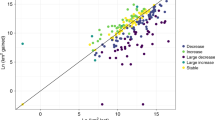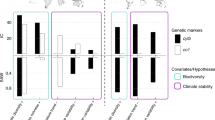Abstract
Mammals are among the fastest-radiating groups, being characterized by a mean species lifespan of the order of 2.5 million years (Myr)1,2. The basis for this characteristic timescale of origination, extinction and turnover is not well understood. Various studies have invoked climate change to explain mammalian species turnover3,4, but other studies have either challenged or only partly confirmed the climate–turnover hypothesis5,6,7. Here we use an exceptionally long (24.5–2.5 Myr ago), dense, and well-dated terrestrial record of rodent lineages from central Spain, and show the existence of turnover cycles with periods of 2.4–2.5 and 1.0 Myr. We link these cycles to low-frequency modulations of Milankovitch oscillations8, and show that pulses of turnover occur at minima of the 2.37-Myr eccentricity cycle and nodes of the 1.2-Myr obliquity cycle. Because obliquity nodes and eccentricity minima are associated with ice sheet expansion and cooling and affect regional precipitation, we infer that long-period astronomical climate forcing is a major determinant of species turnover in small mammals and probably other groups as well.
This is a preview of subscription content, access via your institution
Access options
Subscribe to this journal
Receive 51 print issues and online access
$199.00 per year
only $3.90 per issue
Buy this article
- Purchase on Springer Link
- Instant access to full article PDF
Prices may be subject to local taxes which are calculated during checkout



Similar content being viewed by others
References
Alroy, J. New methods for quantifying macroevolutionary patterns and processes. Paleobiology 26, 707–733 (2000)
Vrba, E. S. & DeGusta, D. Do species populations really start small? New perspectives from the Late Neogene fossil record of African mammals. Phil. Trans. R. Soc. Lond. B 359, 285–293 (2004)
Vrba, E. S. in Paleoclimate and Evolution, with Emphasis on Human Origins (eds Vrba, E. S., Denton, G. H., Partridge, T. C. & Burckle, L. H.) 385–424 (Yale, New Haven, 1995)
Barnosky, A. D. Distinguishing the effects of the Red Queen and Court Jester on Miocene mammal evolution in the Northern Rocky Mountains. J. Vertebr. Paleontol. 21, 172–185 (2001)
Prothero, D. R. & Heaton, T. H. Faunal stability during the Early Oligocene climatic crash. Palaeogeogr. Palaeoclimatol. Palaeoecol. 127, 257–283 (1996)
Alroy, J., Koch, P. L. & Zachos, J. C. in Deep Time: Paleobiology's Perspective (eds Erwin, D. H. & Wing, S. L.) 259–288 (Paleontological Society, Lawrence, 2000)
Barry, J. et al. Faunal and environmental change in the Late Miocene Siwaliks of Northern Pakistan. Paleobiol. Memoirs 3; suppl. to Paleobiology 28, 1–71 (2002).
Laskar, J. et al. A long term numerical solution for the insolation quantities of the Earth. Astron. Astrophys. 428, 261–285 (2004)
Bennett, K. D. Evolution and Ecology: the Pace of Life (Cambridge Univ. Press, 1997)
Dynesius, M. & Jansson, R. Evolutionary consequences of changes in species' geographical distributions driven by Milankovitch climate oscillations. Proc. Natl Acad. Sci. USA 97, 9115–9120 (2000)
Lourens, L. J., Hilgen, F. J., Laskar, J., Shackleton, N. J. & Wilson, D. in A Geological Time Scale 2004 (eds Gradstein, F. M., Ogg, J. G. & Smith, A. G.) 409–440 (Cambridge Univ. Press, 2004)
Lourens, L. J. & Hilgen, F. J. Long-periodic variations in the Earth's obliquity and their relation to third-order eustatic cycles and late Neogene climate change. Quat. Int. 40, 43–52 (1997)
Abdul Aziz, H., Krijgsman, W., Hilgen, F. J., Wilson, D. S. & Calvo, J. P. An astronomical polarity timescale for the late middle Miocene based on cyclic continental sequences. J. Geophys. Res. 108 (B3), 2159–2175 (2003)
Turco, E., Hilgen, F. J., Lourens, L. J., Shackleton, N. J. & Zachariasse, W. J. Punctuated evolution of global climate cooling during the late Middle to early Late Miocene: high-resolution planktonic foraminiferal and oxygen isotope records from the Mediterranean. Paleoceanography 16, 405–423 (2001)
Zachos, J., Shackleton, N. J., Revenaugh, J. S., Pälike, H. & Flower, B. P. Climate response to orbital forcing across the Oligocene–Miocene boundary. Science 292, 274–278 (2001)
Wade, B. S. & Pälike, H. Oligocene climate dynamics. Paleoceanography 19, doi:10.1029/2004PA001042 (2004)
Westerhold, T., Bickert, U. & Röhl, U. Middle to late Miocene oxygen isotope stratigraphy of ODP site 1085 (SE Atlantic): new constrains on Miocene climate variability and sea-level fluctuations. Palaeogeogr. Palaeoclimatol. Palaeoecol. 217, 205–222 (2005)
Abels, H. A. et al. Long-period orbital control on middle Miocene global cooling: integrated stratigraphy and astronomical tuning of the Blue Clay Formation on Malta. Paleoceanography 20, doi:10.1029/2004PA001129 (2005)
Zachos, J., Pagani, M., Sloan, L., Thomas, E. & Billups, K. Trends, rhythms, and aberrations in global climate 65 Ma to present. Science 292, 686–693 (2001)
Daams, R. et al. Stratigraphy and sedimentology of the Aragonian (early to middle Miocene) in its type area (north-central Spain). Newslett. Stratigr. 37, 103–139 (1999)
Alonso Zarza, A. M. & Calvo, J. P. Palustrine sedimentation in an episodically subsiding basin: the Miocene of the northern Teruel Graben. Palaeogeogr. Palaeoclimatol. Palaeoecol. 160, 1–21 (2000)
Abdul Aziz, H., van Dam, J. A., Hilgen, F. J. & Krijgsman, W. Astronomical forcing in Upper Miocene continental sequences: implications for the Geomagnetic Polarity Time Scale. Earth Planet. Sci. Lett. 222, 243–258 (2004)
Mein, P., Moissenet, E. & Adrover, R. Biostratigraphie du Néogène supérieur de Teruel. Paleont. Evol. 23, 121–139 (1990)
Leroy, S. & Dupont, L. Development of vegetation and continental aridity in northwestern Africa during the Late Pliocene: the pollen record of ODP Site 658. Palaeogeogr. Palaeoclimatol. Palaeoecol. 109, 295–316 (1994)
Hilgen, F. J., Abdul Aziz, H., Krijgsman, W., Raffi, I. & Turco, E. Integrated stratigraphy and astronomical tuning of the Serravallian and lower Tortonian at Monte dei Corvi (Middle-Upper Miocene, northern Italy). Palaeogeogr. Palaeoclimatol. Palaeoecol. 199, 229–264 (2003)
van Dam, J. A. & Weltje, G. J. Reconstruction of the late Miocene climate of Spain using rodent paleocommunity successions: an application of end-member modelling. Palaeogeogr. Palaeoclimatol. Palaeoecol. 151, 267–305 (1999)
van Dam, J. A. Anourosoricini (Soricidae, Mammalia) from the Mediterranean Region: a pre-Quaternary example of recurrent climate-controlled North-South range shifting. J. Paleontol. 78, 741–764 (2004)
Tuenter, E. Modeling Orbital Induced Variations in Circum-Mediterranean Climate. PhD thesis, Utrecht Univ. (2004)
Sheldon, P. R. Plus ça change—a model for stasis and evolution in different environments. Palaeogeogr. Palaeoclimatol. Palaeoecol. 127, 209–227 (1996)
Heslop, D. & Dekkers, M. J. Spectral analysis of unevenly spaced climatic time series using CLEAN; signal recovery and derivation of significance levels using a Monte Carlo simulation. Phys. Earth Planet. Inter. 130, 103–116 (2002)
Acknowledgements
We thank the Netherlands Organisation for Scientific Research and the Communidad Autónoma de Madrid for financial support, and the Ministerio de Educacion y Ciencia (Madrid), the Diputacion General de Aragón (Zaragoza), and the Fundación Conjunto Paleontológico (Dinópolis, Teruel) for their support with regard to fieldwork campaigns. We also thank H. Abels, H. Dijkstra, D. Heslop, B. Engesser, R. Hengeveld, K. Kuiper, D. Mayhew, E. Sanz, E. Tuenter and G. J. Weltje for discussions and help. We thank I. Lacomba for supplying unpublished data and we are grateful to the late R. Daams for his important contribution to the Central Spanish rodent database.
Author information
Authors and Affiliations
Corresponding author
Ethics declarations
Competing interests
Reprints and permissions information is available at www.nature.com/reprints. The authors declare no competing financial interests.
Supplementary information
Supplementary Notes
This file contains information on age calibrations, treatment of age uncertainties and taxonomy, and supplementary references. (PDF 69 kb)
Supplementary Tables
This file contains Supplementary Table 1 with locality information, and Supplementary Table 2 with correlations between marine δ18O events, orbital extremes and rodent turnover peaks. (PDF 45 kb)
Supplementary Figures
This file contains Supplementary Figures 1–7. (PDF 227 kb)
Rights and permissions
About this article
Cite this article
van Dam, J., Abdul Aziz, H., Ángeles Álvarez Sierra, M. et al. Long-period astronomical forcing of mammal turnover. Nature 443, 687–691 (2006). https://doi.org/10.1038/nature05163
Received:
Accepted:
Issue Date:
DOI: https://doi.org/10.1038/nature05163
This article is cited by
-
Life rather than climate influences diversity at scales greater than 40 million years
Nature (2022)
-
Earth’s eccentric orbit paced the evolution of marine phytoplankton
Nature (2022)
-
Middle Ordovician astrochronology decouples asteroid breakup from glacially-induced biotic radiations
Nature Communications (2021)
-
Impact of 10-Myr scale monsoon dynamics on Mesozoic climate and ecosystems
Scientific Reports (2020)
-
First levantine fossil murines shed new light on the earliest intercontinental dispersal of mice
Scientific Reports (2019)
Comments
By submitting a comment you agree to abide by our Terms and Community Guidelines. If you find something abusive or that does not comply with our terms or guidelines please flag it as inappropriate.



